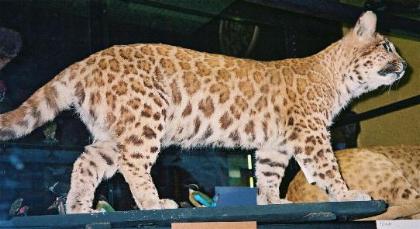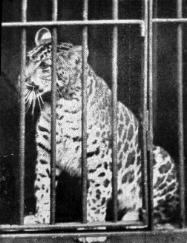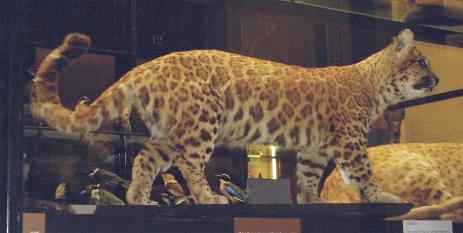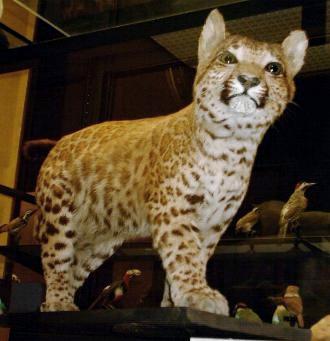A pumapard is the hybrid of a puma and a leopardess. In the late 1890s/early 1900s, two hybrids were born in Chicago, followed 2 years later by three sets of twin cubs born at a zoo in Hamburg, Germany from a puma father and leopard mother. Carl Hagenbeck apparently bred several litters of puma x leopard hybrids in 1898 at the suggestion of a menagerie owner in Britain. Hagenbeck had bought a 9 month old female puma-leopard cub from Anderton & Haslam's menagerie in January 1898 for 26 guineas, along with its parents, a female puma and her male leopard companion, so he is likely to have repeated the mating.
HYBRID PUMA AND LEOPARD. (The Field, 29th June 1895). SIR,—I think the following case of hybridism sufficiently interesting to record: In Anderton's menagerie there is a female puma, but no male. She was put to a large, fine male leopard, and has produced three cubs, two of which died. The third, which I saw , is now a fortnight old. It has a puma's muzzle; and the spots, instead of radiating round a yellow ocellus, as in the leopard, are dark solid blotches. Of course this may alter with age. Its fertility, if it lives, of course remains to be proved. - ARCHER VASSALL. Mandeville, Godalming.
[The occurrence of a hybrid between two species of the genus Fells so distinct in colour and locality — the puma being American and the leopard from Asia or Africa — is exceedingly interesting mad well worthy of record.—ED.]
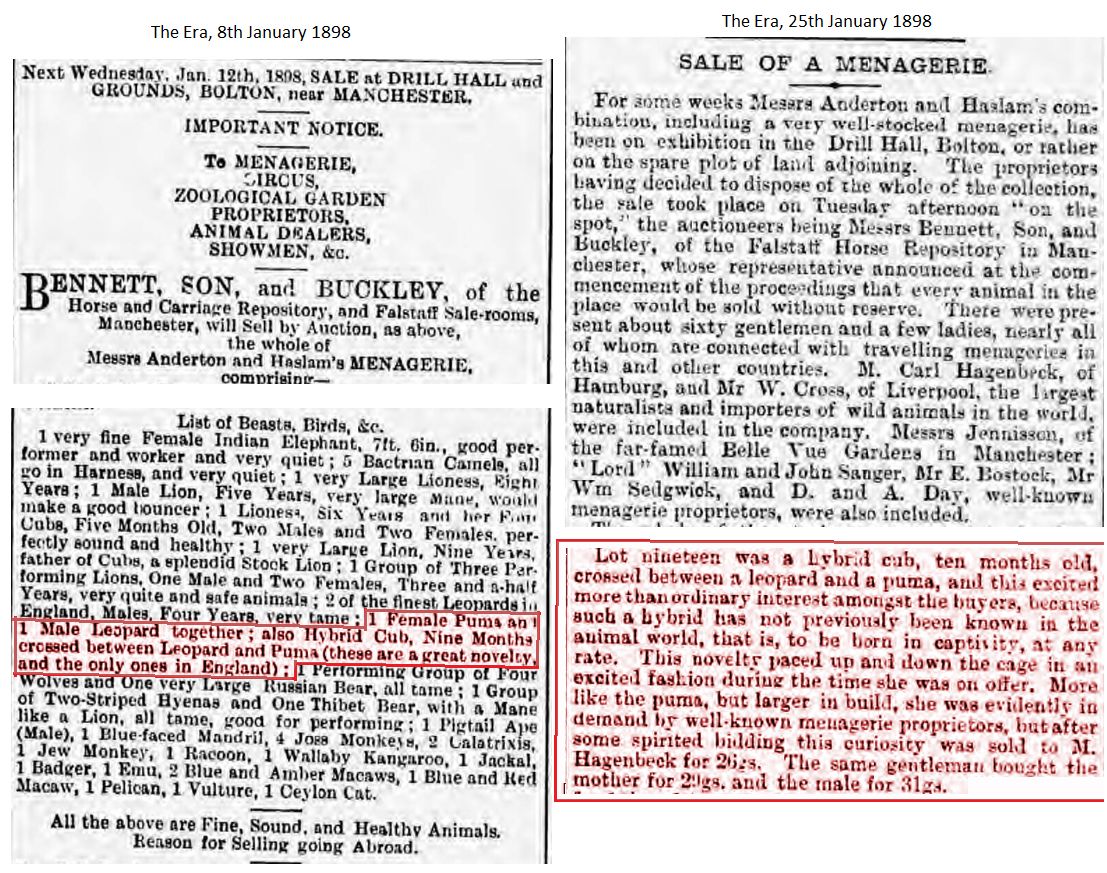
[HYBRIDS] The Boston Globe (Massachusetts), 3rd June 1906, pg 38
“Wonder” and “Land,” the hybrid panther and leopard cubs of Ferari’s wild animal show at Wonderland, are as lively as kittens, and their panther mother fondles her two tiny brown and black offspring with true maternal tenderness. The trio are a sensation of the animal tent and evoke no end of curiosity.
CUBS OF LEOPARD FATHER AND PANTHER MOTHER. The Boston Globe (Massachusetts), 1st August 1906, pg 7.
Only Examples of their Kind in the World Visit the Globe Office – Marvel of Animal Experts.
“Wonder,” nine weeks old, described by his keeper as the “nastiest animal of his age I ever saw,” came to Boston yesterday, snarling, snapping, clawing, spitting and expressing his general objection to everybody and everything he saw. “Wonder” is an all-round-bad-egg, but he is only a little worse than his partner, “Land,” who was with him.
“Wonder” and “Land” are the only living examples of their kind, and so far as is known the only examples there ever were. They are sui generis, and they must have been fully conscious of their exclusiveness in the animal world, for yesterday they clawed red streaks in the hands of Joseph G. Ferari, their guardian, spat and snarled at the photographer who was taking their pictures, tore long rents in the upholstery of the automobile provided for their enjoyment, and were as hard to handle as a whole menagerie of grown ups. Every time they had an audience, which was practically all the time, “Wonder” and “Land” seemed to be imbued with this spirit: “We are the get of two most treacherous species of the jungle and we have got to live up to the reputation of our parentage.” And they did.
“Wonder” and “Land” were born at Wonderland park, Revere beach, nine weeks ago, and yesterday was their first afternoon away from the maternal side of the South American panther mother who nurses them. They had not seen much of the world up to yesterday afternoon, when Joseph G. Ferari, of Ferari’s trained wild animal show, and George Dobbins, manager of the Wonderland animal exhibition, bundled them into an automobile and drove them up to the Globe office to have their pictures taken. They did not like anybody or anything. They insisted upon turning their backs to the camera, would not let the artist get a good view of their spiteful countenances, and showed a disposition to fight without provocation. “Wonder” had the abhorrence of a camera which a society leader assumes, and he made several vicious passes at the instrument while his keeper was trying to get him in presentable position to be taken.
“Land” was a little more tractable, but when the artist had fixed the imprint of the physical proportions of “Wonder” and “Land” on his plate Joseph G. Ferari’s hands needed the attention of a physician, for the sharp claws of the 9-weeks-old had drawn blood from a score of deep rents. The two tawny, spotted animals, who at nine weeks are able to teach a trained keeper caution, are known as panther-hybrids. Nothing like them has ever been born in the world before, and trainer Ferari says he thinks they are in a fair way to make the ugliest and most treacherous beast in or out of captivity. The father of “Wonder” an “Land” is an East India leopard, who was captured in the forest when he was about three years old. The mother is a South American panther, who up to the age of two dwelt in the wilds. Through fortune which is to animal trainers incredible, the leopard and the panther bred and the cubs which are the result are the marvel of animal men.
In captivity up to this time leopards and panthers have shown the strongest aversion to each other. They would not associate and it was even dangerous to attempt to keep them in one cage. But Mr Ferari succeeded after much trial in finding one of each specie which would mate with the other. These panther-hybrids in the nine weeks they have been on earth have shown, Mr Ferari says, all the vicious characteristics of leopard and panther. As Mr Ferari says, the little fellows at their age ought to be as easy to handle as kittens, since lions, tigers, panthers and other ferocious beasts can be trained without danger, but yesterday he had to be as much on the alert for the sharp claws of the babies as if they were yeas instead of weeks old.
They are very interesting curious and they are also very good specimens, strong and vigorous. Both show the panther and leopard blood. The gray in the tawny coat and the spots are from the father, the leopard, while the dark buff of the coat is of the mother. The head and back are those of the panther mother, and the movement, the loping, stealthy stride indicate strongly the predominance of the panther maternal blood.
“When these kittens are 4 weeks older it will be impossible for us to attempt to touch them with our hands,” said Mr Ferari. “Never have I seen the vicious element in animals developed so young. What they will be, what characteristics growth will develop we do not know. They are an enigma, a problem. I think they will be an interesting study.”
After their excursion to town “Wonder” and “Land” late in the afternoon were restored to the care of their panther mother at Wonderland park and it was curious to observe the way the panther snarled as she smelled the traces of numerous human hands on the coats of her offspring.
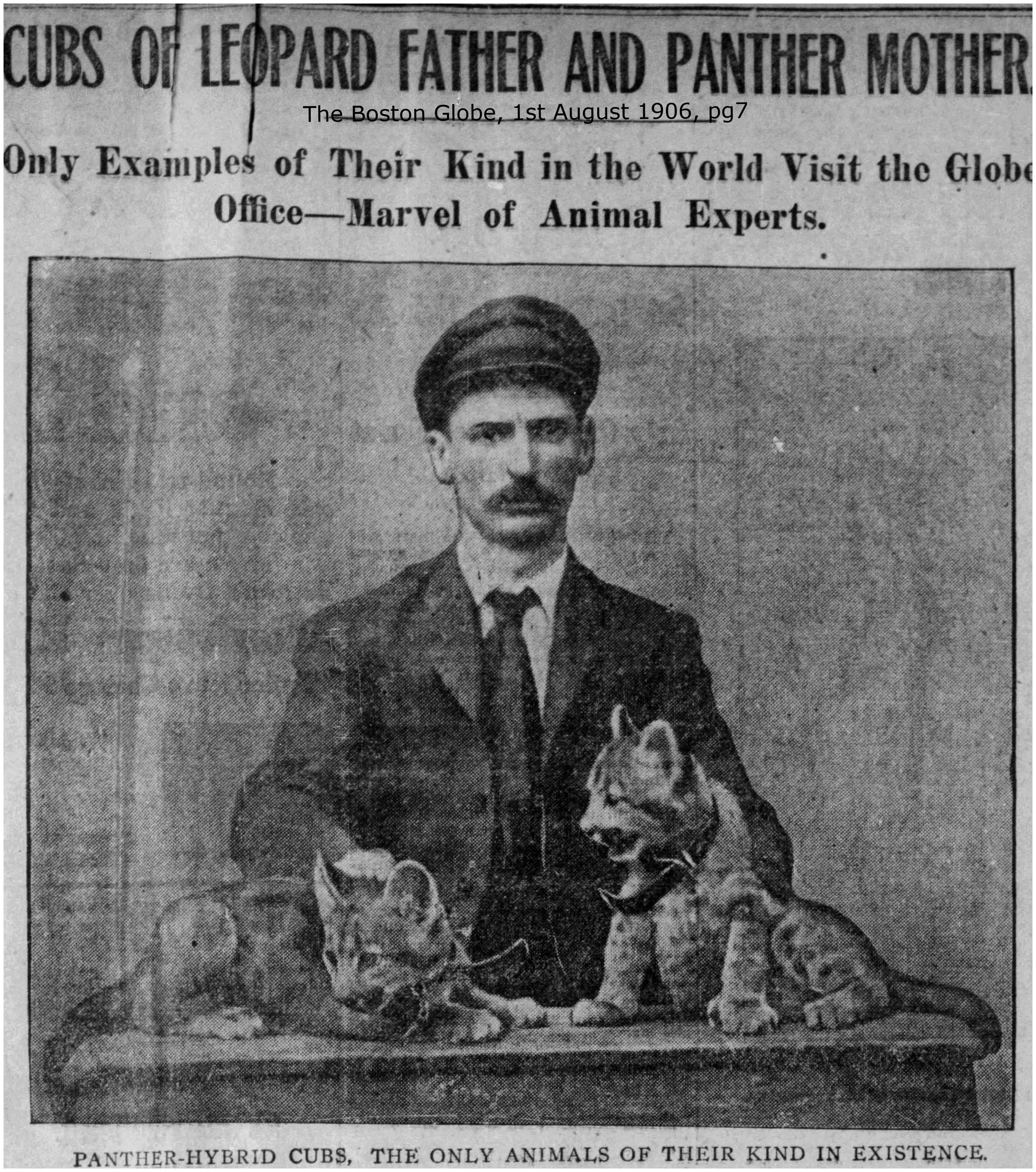
Both male puma x female leopard and male leopard x female puma pairings have produced offspring. Hamburg Zoo had a hybrid (the one in the black and white photo) fathered by a puma bred to an Indian leopardess. A specimen purchased in 1898 by Berlin Zoo from Carl Hagenbeck was a cross between a male leopard and a female puma (the same as the Chicago hybrids). Various newspapers published this report in early 1903: “The first successful experiment I made was with a leopard and a puma," said Mr. Hagenbeck recently. “And the only living animal of the litter I sold some time ago to the Berlin Zoological Garden, where it Is still in the collection.” In The Field No 2887, April 25th, 1908, Henry Scherren wrote "Writing in Zoologischer Garten (1903, pp. 288-90), Forstmeister Adolf Rorig, of Frankfort-on-the-Main, gave a summary of the notices of feline hybrids that had previously appeared in that journal. There was, and probably is now, in the Berlin Garden and Indian leopard and puma male hybrid, purchased of Carl Hagenbeck in 1898. In his “Guide” Dr Heck described it as “a little grey puma with large brown rosettes.” Another hybrid between the same species, but with a puma for sire and a leopard from dam, was recently at Stellingen; it resembled the female parent in form, as may be seen from the reproduction from a photograph taken there." Hagenbeck much later wrote (1951) that a male puma and female leopard produced a hybrid cub that was reared by a Fox terrier bitch (this was common practice to ensure a tamed individual) at Hagenbeck Tierpark, Hamburg. The hybrid was male and intermediate between the puma and leopard in colour and pattern, having faint leopard spots on a puma-coloured background. The body length was much less than either parent and the tail was long, like the puma.
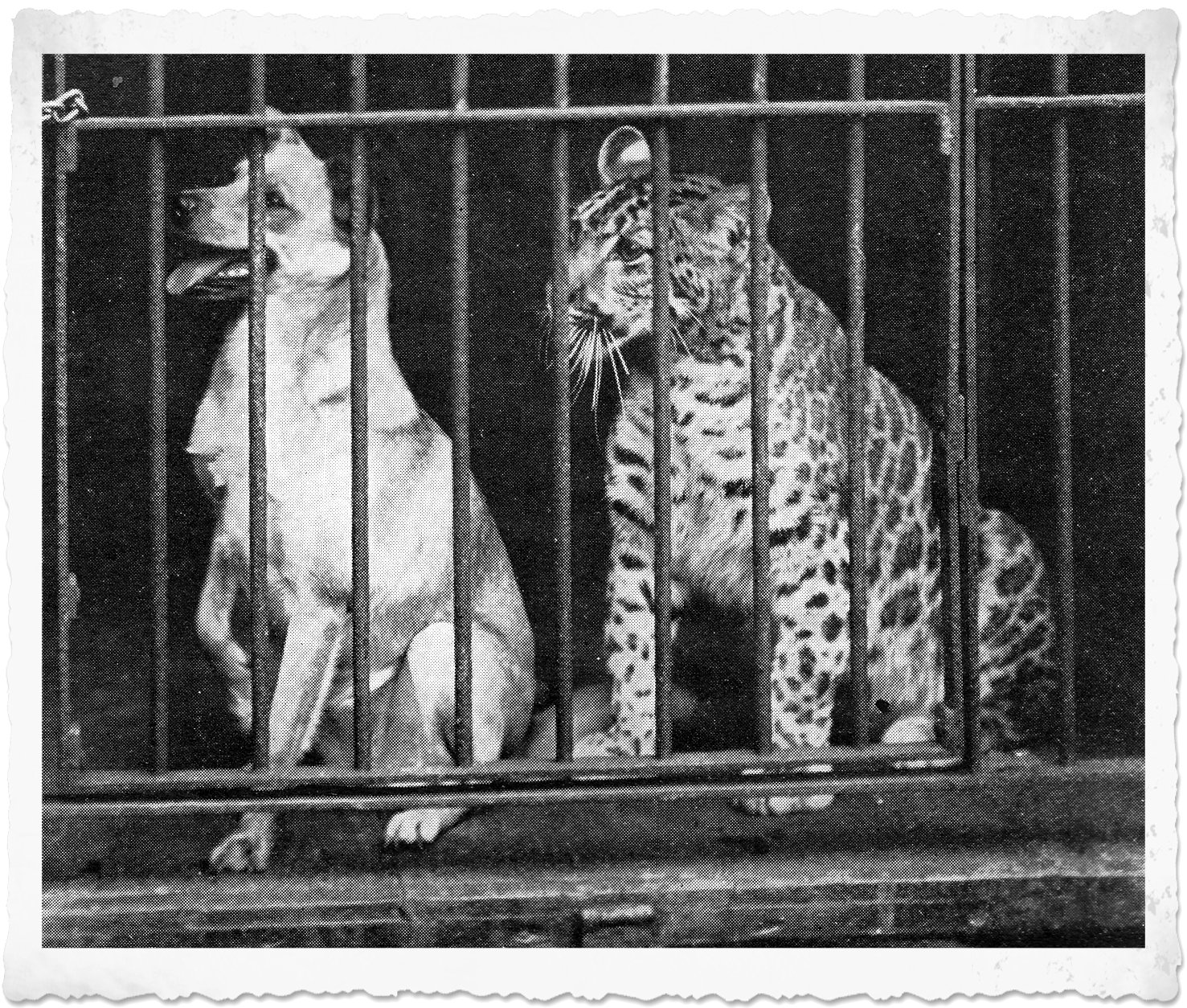
A pair of leopard x puma hybrid cubs were born in Chicago on 24 April 1896 at Tattersalls indoor arena where Ringling Brothers Circus opened its season. Details about the two cubs were published in The Chicago Chronicle on 25th April 1896: Two tiny cubs which look like young leopards were born at Tattersall's where Ringling Brothers circus is housed, yesterday (24 APR [18]96). They are not leopards, however. Their mother is a mountain lion or cougar and their father is a leopard. They take after their father decidedly, and are the daintiest little members of the cat family ever born in captivity. In fact they are the only ones of their kind, so far as known, ever born, either within the confines of a cage or anywhere else. These black and yellow youngsters were on exhibition yesterday and were admired by all who saw them. They will probably be on view the rest of the time the circus exhibits in Chicago.
H Petzsch (1956) mentioned that puma/leopard hybrids had been obtained by artificial insemination.
Dr Helmut Hemmer (1966) reported a hybrid between a male Indian leopard (P pardus fusca) and female puma as being fairly small with a ground colour like that of the puma and having rather faded rosettes.
This is a still from a video recording of "ATV Today" on 13th May, 1981, a segment of Southam Wildlife Park. By that time is was owned by the Jones family and housed big cats. It was struggling to attract visitors, on one special opening day it attracted only 10 admissions. It had had a problem earlier when a lioness had mauled a girl and there were calls to end its big cat petting sessions so it was eager for publicity. In 1978 it had claimed a panther-tiger hybrid, which was actually a pure tiger that was later sold to a circus. The full clip is owned by MACE (Media Archives of Central England) and listed at 1981 Alleged Leopard Puma Hybrids, Southam Wildlife Park , but has not been digitised for public viewing. While these aren't the leopard-puma hybrids they claim to be, I found it worth debunking the misleading claim.
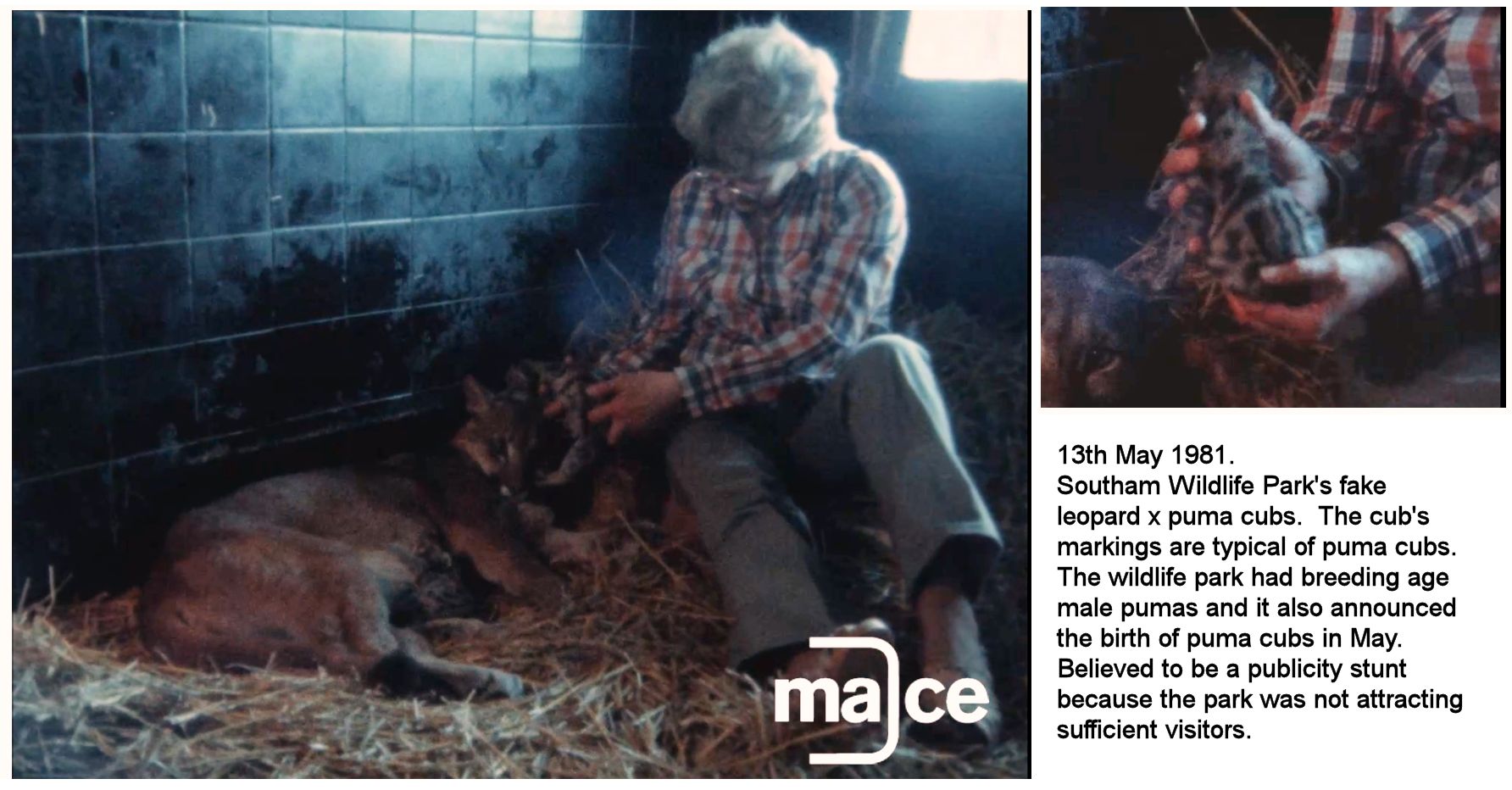
In May 1981, Southam Wildlife Park claimed to have successfully mated Sampson the leopard with Poppette the puma resulting in cubs that were puma coloured with some spots. Looking at the still, the cubs are normal puma cubs, but the public may not have known that puma cubs are spotted or blotched. They lack the rosette pattern found on genuine hybrids and they have dark dorsal stripes, which were not found on genuine hybrids. From all reports, the Wildlife Park was doing quite badly in the early 1980s. On one "special opening" day it only got 10 visitors, so it would have been desperate for publicity and novel attractions.
If Sampson was not the father, who was? In 1979, the zoo had a cougar called "Snooty"(Coventry Evening Telegraph, 26th October 1979), though its gender isn't mentioned. In 1980, there was a puma called Peebles which had 2 cubs, Snooples and Dooples (Daily Mirror, 16th October 1980) which means they definitely had a breeding age male puma. There was also a puma cub at the zoo in May 1981 (Daily Mirror, 30th May 1981). The claim of the leopard being the sire was purely for publicity; there is no long term follow up on the cubs, so either they died or they were shifted out of sight when their true identities became obvious.
Nancy Neff in her introduction to Guy Coheleach's "The Big Cats": "the
ability to hybridize may seem to contradict the status of...cats as
separate species, since species
are usually defined as populations of animals who interbreed among
themselves but who are unable to interbreed under natural
conditions with other such groups." Neff viewed with "extreme interest,"
instances of captive cross-breeding between the more distantly related
puma and leopard (as opposed to lion-tiger, lion-leopard and
leopard-jaguar pairings) since - at the time she wrote her introduction
- the puma was not considered a pantherine. Thus, referring to the puma,
"the ability to hybridize with the leopard is quite unexpected." She felt the
ability of pumas and leopards to interbreed may be explained by
immunological findings placing them both in the pantherine lineage.
More recently, the American "X-Project Magazine" reported that Britain's Exmoor Beasts are believed to be descended from a black puma x leopard hybrid. The limited gene pool "fixed" the recessive black colour and the adaptability of the puma ensured its survival. This is actually impossible because melanism has never been verified in pumas; the black big cats kept as pets in Britain were black panthers (leopards) and black jaguars and moreover, a self-sustaining population of hybrid big cats is extremely unlikely due to problems of sterility in the males. Additionally there is the problem of dwarfism observed in puma x leopard hybrids, although it isn't clear whether any of the hybrids reached their adult size. (See
Hybrid Big Cats In The British Countryside )
Confusingly, it has been reported that most pumas kept as pets in the United Kingdom were black rather than tawny; the rarity of black pumas makes this extremely unlikely. This confusion arises because pumas are also known as panthers and black panthers (black leopards) were indeed kept as pets. The confusion is worsened by articles which erroneously refer to "the black puma out of The Jungle Book" (pumas are not found in India!). Unlike black panthers, supposed "black pumas" ("couguar noire") have dark upper parts, but pale bellies.
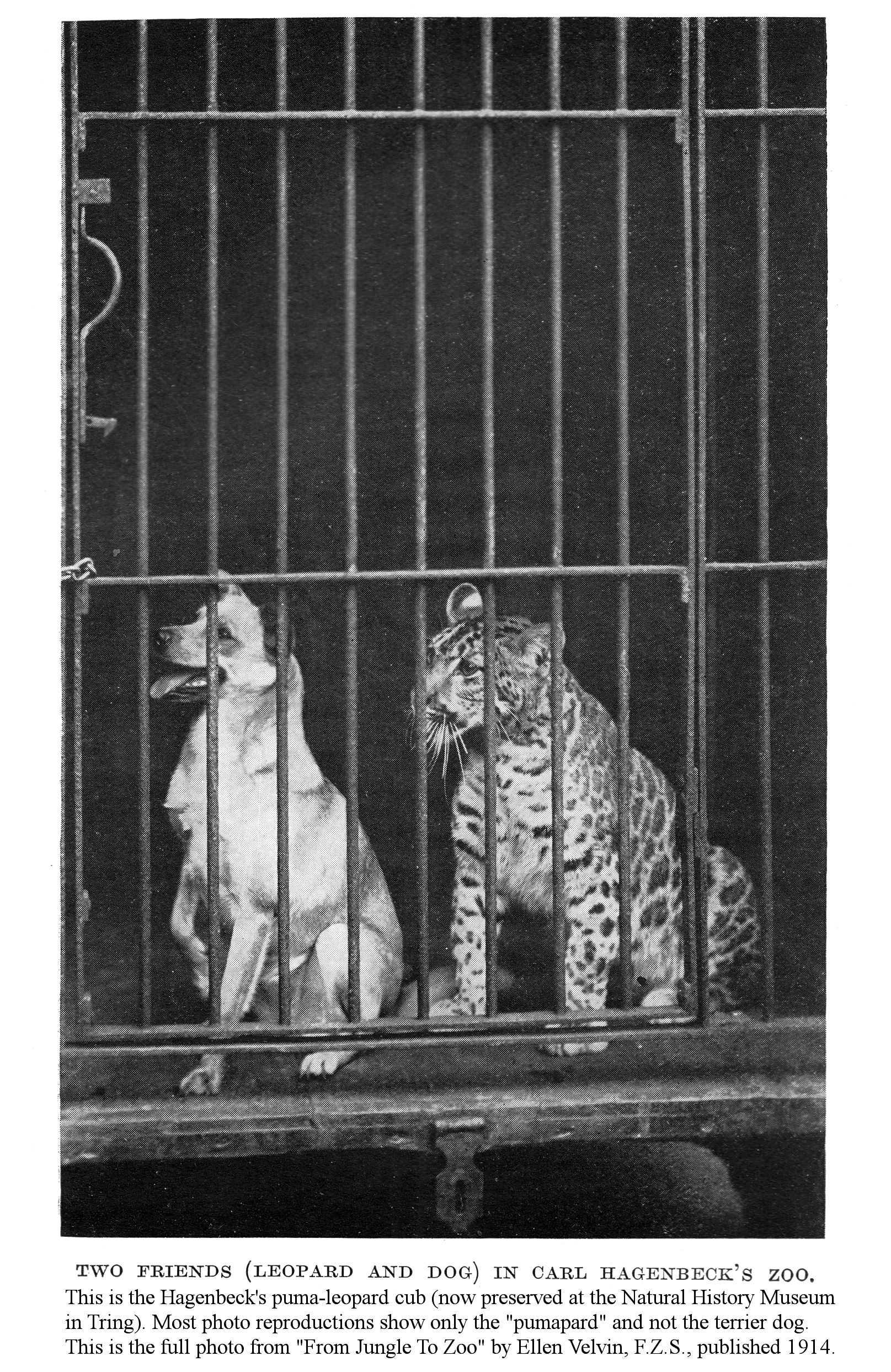
PUMA/JAGUAR HYBRIDS
REMARKABLE HYBRIDS. Alexandria Gazette (Virginia), 17th January 1900, pg 1.
It has been tried many times in the past, but has, it is claimed, always been unsuccessful heretofore. The attempt to mate a puma and a leopard, or a puma and a jaguar, has also been tried, but has resulted each time in the injury of the puma.
A supposed puma x jaguar hybrid was shot in the Mato Grosso, South America in the early half of the 20th Century. It was killed by Sacha Siemel whose opinion was that it was a puma x jaguar hybrid. It was heavily built with brown spots on a fawn background and a dark stripe down its back. Pumas and jaguars are both present in the area, but occupy different niches and would be unlikely to meet, let alone mate. The description of the supposed puma/jaguar hybrid was very similar to that of the captive-bred pumapards. Successful hybridization between pumas and jaguars in captivity has been alleged (in a report by Dr Helmut Hemmer, 1966), but there is no photographic evidence. The hybrids would look similar to pumapards, but with jaguar-like, rather than leopard-like, markings and would possibly be more powerfully built.
These reports, which contain a lot of showman's hype, also allude to puma/jaguar hybrids. From The New York Times of June 4th, 1906 we have “ALL HYBRIDS AT CONEY. Some Beasts There Are Bi-Hybrids This Year—All Are Mighty Rare. Bulletin chased bulletin out of the animal shows at Coney Island yesterday. A Coney Island animal show is a cheap affair this year if it hasn’t at least one hybrid; naturally the press agents aren't forgetting that fact. Bostock’s press agent announced, with tears in his voiced that “Tricolor,” the Bostock hybrid, had just died. At the same time, however, there were born to the lioness Princess two tiny cubs. Their father is said to be a cross between a puma and “the famous self-eating Jaguar whose favourite occupation is biting a section of his own tail off.” Tricolor was only a cross of a puma, a jaguar, and a lion. That, the press agent says, is quite a common cross. The new cubs, of course, are very rare.” At the same time, various papers reported that “Tricolor,” the Bostock leopard-lion-tiger hybrid, died, and a lioness in Mr. Bostock’s menagerie had given birth to a pair of puma-jaguar-lion prodigies.
Like lion cubs, puma cubs have rosetted markings; the supposed hybrid might have been an individual which had retained its spots into adulthood.
